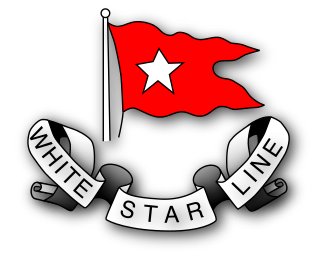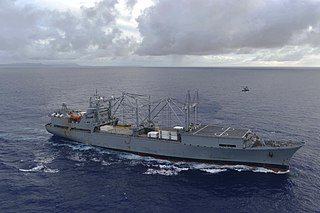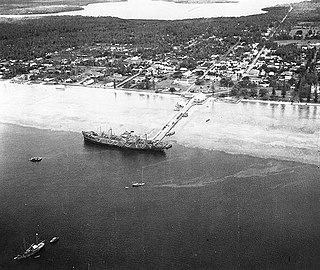This page is based on this
Wikipedia article Text is available under the
CC BY-SA 4.0 license; additional terms may apply.
Images, videos and audio are available under their respective licenses.

SS Patrick Henry was the first Liberty ship launched. It was built by the Bethlehem Shipbuilding Corporation at their Bethlehem-Fairfield Shipyard in Baltimore, Maryland, and launched on 27 September 1941.
Type C1 was a designation for small cargo ships built for the U.S. Maritime Commission before and during World War II. The first C1 types were the smallest of the three original Maritime Commission designs, meant for shorter routes where high speed and capacity were less important. Only a handful were delivered prior to Pearl Harbor. But many C1-A and C1-B ships were already in the works and were delivered during 1942. Many were converted to military purposes including troop-transports during the war.

The SS William and Mary was a Victory ship built during World War II.

SS Prinz Friedrich Wilhelm was an ocean liner for North German Lloyd (NDL) from her launch in 1907 until the end of World War I. After the war, she briefly served as USS Prinz Friedrich Wilhelm (ID-4063) for the United States Navy returning American troops from France. The vessel was first chartered—and later purchased outright—by Canadian Pacific Steamships (CP) and operated under the names Empress of China, Empress of India, Montlaurier, Monteith, and Montnairn. She was scrapped in 1929.

The Athenic-class ocean liners were a three ship class of ocean liners built by the Harland & Wolff shipyard for the White Star Line in the early 20th century.
SS Mercer Victory was a Boulder Victory-class cargo ship built for World War II. Mercer Victory, a Victory ship, was launched 14 March 1945 by Permanente Metals Corporation, Richmond, California and operated by the States Marine Line. At the ceremonial ship launching, Mercer University President Spright Dowell said the SS Mercer Victory should strive: “to do her full-part for the national defense” and “to study a plan for after war conditions and needs.”
Two ships of Moore-McCormack have borne the name Mormactern
Three ships of the Moore-McCormack companies have borne the name Mormacdove
Two ships of Moore-McCormack have borne the name Mormacgull
Three ships of Moore-McCormack have borne the name Mormachawk
Three ships of Moore-McCormack have borne the name Mormacwren

SS Gallic was a cargo steamship built in 1918. During her career, she had six different owners and sailed under the flags of the United Kingdom, Panama and Indonesia. In spite of prevailing maritime superstition that it is unlucky to change a ship's name, she underwent seven name changes and survived a 37-year career unscathed. She was scrapped at Hong Kong in 1956, the last surviving White Star Line cargo ship.
Five ships of Moore-McCormack have borne the name Mormacsun

SS Claymont Victory was a Type C2 Victory ship-based VC2-S-AP2 troop transport built for the U.S. Army Transportation Corps late in World War II. Launched in November of 1944, it saw service in the European Theater of Operations during 1945 and in the immediate post-war period repatriating U.S. troops.

The SS St. Lawrence Victory (MCV-735) was a type VC2-S-AP2 Victory-class cargo ship built for the United States during World War II. The ship was built as part of the Emergency Shipbuilding program by Permanente Metals Corporation in Yard 2 of the Richmond Shipyards in Richmond, California.

The Type C5 ship is a United States Maritime Administration (MARAD) designation for World War II breakbulk cargo and later a container ship for containerization shipments. The first type C5 class ship was a class of ships constructed and produced in the United States during World War II. The World War II C5 class ship was dry bulk cargo ship built by Bethlehem Steel in Sparrows Point, Maryland. Bethlehem Steel built 8 ship in this bulk cargo class and four orders were canceled. The C5 class ship has a DWT of 24,250 and was 560 feet long. The C5 was mainly used as iron ore carriers. The C5 was needed to replace other ships that sank during WW2. First in her class was the SS Venore, USMC #1982, delivered on 20 July 1945. Type C5 class ship designed to fill the need to move iron ore from Santa Cruz, Chile, to Sparrows Point, Md., through the Panama Canal, a round-trip trip 8700 nautical miles.
Post World War 2 four ships were given C5 class type C5-S-78a, these were roll-on/roll-off container ship built by Ingalls Shipbuilding, Inc. of Pascagoula, Mississippi and operated by the Moore-McCormack Lines. The C5-S-78a had a deadweight of 16,000 tons.
The Type L6 ship is a United States Maritime Administration (MARAD) designation for World War II as a Great Lakes dry break bulk cargo ship. The L-Type Great Lakes Dry Bulk Cargo Ships were built in 1943 for World War II. The ships has a 15,82 deadweight tonnage. The L6 ships were built by two companies: American Ship Building Company and Great Lakes Engineering Works,Ashtabula, Ohio/ Great Lakes Engineering Works, River Rouge, Ohio that built the type L6-S-B1 and American SB that built the class L6-S-A1. Steel supply needed for World War was great. To supply iron ore from Lake Superior to steel foundries, the United States Commission had a series of L6 Lakers ship built. The Maritime Commission ordered ten Great Lakes Bulk Carriers of the L6-S-B1 type. The L6-S-B1 was design with a 3-cylinder triple expansion steam engines. The L6-S-A1 used a lentz 4-zylinder compound engines. All L6 ships were coal burning and delivered between May and November 1943. L6-S-B1 was built for the US Maritime Commission under USMC contract MCc-1834 in 1943 at the River Rouge yard. Each L6 ship cost $2.265 million. The first L6-S-B1 was the SS Adirondack/Richard J. Reiss, hull 290, keel was laid on March 9, 1942 and launched on September 19, 1942. The ships are often called the Class Lake Bulk Freighter now.

The Type R ship is a United States Maritime Administration (MARAD) designation for World War II refrigerated cargo ship, also called a reefer ship. The R type ship was used in World War II, Korean War, Vietnam War and the Cold War. Type R ships were used to transport perishable commodities which require temperature-controlled transportation, such as fruit, meat, fish, vegetables, dairy products and other foods. The US Maritime Commission ordered 41 new refrigerated ships for the US Navy. Because of the difficulty of building refrigerated ships only two were delivered in 1944, and just 26 were delivered in 1945 and the remainder in 1946–48. The 41 R type ships were built in four groups. Two of design types were modified type C1 ships and two were modified type C2 ships. The United Fruit Company operated many of the R type ships in World War II. The type R2-S-BV1 became the US Navy Alstede-class stores ship and the type R1-M-AV3 became the US Navy Adria-class stores ship.

The SS Baylor Victory was a cargo Victory ship built during World War II under the Emergency Shipbuilding program. The Baylor Victory (MCV-772) was a type VC2-S-AP2 Victory ship built by California Shipbuilding Corporation in Los Angeles, California. The Maritime Administration cargo ship was the 772rd ship built. Her keel was laid on Jan. 13, 1945. She was launched on March 6, 1945 and completed on March 30, 1945. The 10,600-ton ship was constructed for the Maritime Commission. She operated her under the United States Merchant Marine act for the War Shipping Administration. She was named for Baylor University a private Christian university in Waco, Texas. At her launching Baylor University was represented by 18 graduates and friends. University President Pat M. Neff gave a short speech at the launching and christening ceremony. Los Angeles District Judge Minor L. Moore, a Baylor graduate of 1900 also spoke. Baylor Victory was launched at 1:20am and was lite up by large floodlights.











